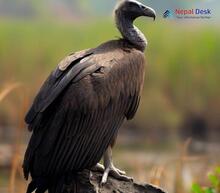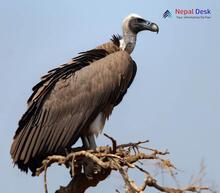The Gyps genus comprises seven species of medium to large-sized vultures in the family Accipitridae. Ranging across Europe, Africa, and Asia, Gyps vultures fill an important ecological role as scavengers that dispose of animal carcasses across diverse habitats.
Three Gyps species occur in Nepal - the Eurasian griffon (Gyps fulvus), Himalayan griffon (Gyps himalayensis), and white-rumped vulture (Gyps bengalensis). As the primary scavenging bird in Nepal, the Gyps genus provides an invaluable service in cleaning up livestock carcasses quickly before disease can spread.
Globally, many Gyps vulture populations are under threat from poisoning, disturbance, and declines in food availability. Their extinction could have cascading impacts on ecosystem health and dynamics. Protecting these birds in Nepal and beyond is crucial for maintaining biodiversity as well as securing public health through the regulation of infectious diseases.
With this background on the ecological significance of the Gyps genus worldwide and in Nepal, the rest of this review will provide deeper insights into the evolution, biogeography, morphology, behavior, and conservation status of these essential avian scavengers. Their unique adaptations and cultural symbolism also showcase the magnificent biodiversity of the Himalayas.
Taxonomy and Classification
The Gyps genus belongs to the larger Accipitriformes, including hawks, eagles, kites, and Old World vultures. All members of this order are diurnal birds of prey with strong hooked beaks, sharp talons, and excellent eyesight.
Within the Accipitridae family, the Gyps genus is placed in the subfamily Aegypiinae, known as the Old World vultures. This subfamily consists of 14 species across 5 genera. Gyps vultures are distinguished by their larger body size and primary dependence on scavenging rather than hunting live prey.
The Gyps genus itself contains 7 extant species:
- Eurasian griffon (Gyps fulvus)
- Himalayan griffon (Gyps himalayensis)
- White-rumped vulture (Gyps bengalensis)
- Indian vulture (Gyps indicus)
- Slender-billed vulture (Gyps tenuirostris)
- Cape griffon (Gyps coprotheres)
- Rüppell's vulture (Gyps rueppelli)
Of these, three species span parts of Nepal - G. fulvus, G. himalayensis, and G. bengalensis. The remaining species are restricted to Africa or other parts of Asia. All members of this genus play important ecological roles as scavengers on carcasses and help prevent the spread of disease across their ranges.
This summarizes the taxonomic classification and species diversity within the Gyps genus of globally distributed Old World vultures. The next sections will provide more details on the evolutionary history, morphology, and behavior of this vital genus of birds.
Physical Characteristics
Species in the Gyps genus share several common physical attributes that equip them for a scavenging lifestyle. As large vultures, they have broad, elongated wings designed for soaring flight to scan the landscape and locate carcasses from far away. Their featherless heads and short, thick necks filled with powerful keratin facilitate plunging one’s head deep inside rotting carcasses to reach food.
The Eurasian griffon vulture is the largest Old World vulture with a wingspan approaching 3 meters. The Himalayan griffon is slightly smaller but possesses specialized adaptations for high altitudes like efficient oxygen processing ability, scaled armor on legs to withstand freezing temperatures, and dense plumage for insulation.
The smaller white-rumped vulture exhibits dark grey plumage except for the namesake white patches on its lower back and hindneck. Its feathers help camouflage the bird as it roosts on cliffs and trees. This species also has a uniquely serrated middle talon on its feet to aid in gripping slippery bones and carcasses.
These salient adaptations found across Nepalese Gyps species highlight the close coevolution they share with their extreme Himalayan habitat. Protecting these specialized endemic vultures preserves the essence of the Himalayan region’s incredible biodiversity.
Species Overview
The Eurasian griffon (Gyps fulvus) is the most widespread Old World vulture, found across Europe, Asia, and North Africa. Nepalese populations frequent grasslands and agricultural areas foraging on livestock carcasses. They are likely a westward extension of Central Asian Eurasian griffon populations and have adapted well to foraging on domestic animals versus wild prey across their global range.
The Himalayan griffon (Gyps himalayensis) is restricted to the Himalayan mountain ranges across Nepal, Bhutan, and Tibet. As the name denotes, this species is specially adapted to high altitudes exceeding 6000 meters through enhanced lung capacity, insulation from dense body feathers, and use of mountain updrafts during flight. Nepalese Himalayan griffons are best equipped to scavenge wild ungulate kills left behind by snow leopards and other Asian predators roaming alpine habitats.
The white-rumped vulture (Gyps bengalensis) inhabits open grasslands and forested areas with cliffs across the Indian subcontinent. The isolated Nepalese subpopulation shows some genetic differentiation from other regional lineages likely due to the rugged terrain surrounding its range. Once highly abundant across Nepal and India, this species has suffered catastrophic declines exceeding 97% due to poisoning by the veterinary drug diclofenac. Targeted conservation intervention may still rescue this species from extinction.
This highlights how geographical isolation and localized adaptation drive divergence between Nepalese Gyps and their related counterparts elsewhere globally. Prioritizing the protection of Nepal’s threatened endemic vultures preserves the country’s role as a global biodiversity stronghold.
Habitat and Distribution
Gyps vultures occupy varied habitats across Europe, Africa, and Asia reflective of their generalist scavenging niches. Most species thrive in mountainous areas with open grasslands and woodlands interspersed with cliffs and rocky outcrops for nesting and roosting sites. A few Gyps like the Eurasian griffon can adapt to semi-urban areas and arid environments.
In the steep Himalayan terrain of Nepal, the distribution and favored habitats of resident Gyps are strongly partitioned by altitude. Eurasian griffons frequent lower hill regions and valleys below 3000 meter in elevation with grasslands and livestock pastures providing foraging opportunities.
Himalayan griffons are specialized for higher altitudes from 1800 to 6000 meters in alpine meadows and barren craggy cliffs of the Nepalese Himalayas. This vertical stratification likely mitigates competition between the species.
Meanwhile, white-rumped vultures tend to nest and roost in lowland forests of the Terai below 1500 meters. But they may soar widely across grasslands and shrublands scanning for carcasses. Fragmentation of such short-stature open habitats due to development has narrowed this already endangered species’ foothold in Nepal.
Conserving contiguous vulture-friendly terrain at varying elevations and ecoregions is thus vital for maintaining Nepal’s avian biodiversity. The country’s montane gradients have facilitated staggered ecological niches for multiple Gyps endemics over evolutionary timescales.
Behavior and Diet
All Gyps vultures display characteristic soaring flight patterns, using uplift wind currents to spot carcasses from distances over 50 kilometers away. Upon landing, groups of up to 100 gather around large carcasses with dominance hierarchies dictating feeding priority. Aggressive hissing and gestures establish rank among jostling individuals.
As obligate scavengers, the bulk of Gyps' diet comprises muscle tissue and organs from large ungulate carcasses. Field observations show Nepalese populations chiefly forage on domestic water buffalo and cattle that represent more common food sources than wild prey. The threatened white-rumped vulture also selectively feeds on bones to obtain calcium.
While Eurasian populations tolerate blighted meat, South Asian Gyps lack protective gut microbes rendering them vulnerable to diclofenac poisoning from cattle carcasses. Just 40-60g of even a few days old contaminated meat is sufficient to cause lethal kidney failure in Gyps endemic to Nepal. Hence the diclofenac crisis has driven an unprecedented decline in regional vulture numbers over the past 20 years.
In summary, a scavenging lifestyle reliant on stochastic food availability shapes the behavior and feeding ecology of Gyps worldwide. However, localized threats like intentional poisoning and food laced with toxic veterinary drugs further endanger Nepalese species on the brink of extinction. Their specialized food preferences also restrict alternatives and underscore the need for targeted conservation policy to secure slaughter waste from contamination.
Reproduction and Lifecycle
Gyps vultures reach sexual maturity between 4-7 years of age. They are seasonal breeders, timing mating and egg-laying during winter and spring depending on the local climate. Nesting sites are chosen on protected cliffs and rock faces or sometimes tall trees that preclude access to terrestrial predators.
Between late October and March, Nepalese populations build large twig nests lined with wool and hair plucked by the birds themselves. A single egg is laid every 1-2 years, and incubated for 45 days with biparental rotation. The semi altricial hatchling fledges after 110-130 days on a diet of regurgitated meat from both parents.
Lifespans average 15-25 years for wild Gyps vultures provided no anthropogenic mortality intervenes. However, the insidious impact of poisoning has truncated the lifespans of South Asian endemics. Nepalese white-rumped vultures now struggle to reach breeding age before succumbing to contaminated carcasses laced with banned veterinary diclofenac. Targeted conservation policy and recovery centers aim to restore natural wild populations before remnant captive flocks expire.
While inherently slow reproducers, the right protective measures anchored in scientific study and policy reform can resuscitate Nepalese Gyps populations decimated by poisoning. These unique endemic species remain integral architects of Asian biodiversity over evolutionary timeframes.
Ecological Role
As nature’s primary scavengers, Gyps vultures provide an invaluable ecosystem service across their global range by rapidly consuming disease-ridden carcasses and preventing the propagation of deadly pathogens. Large congregations strip even big carcasses to the bone within hours. This regulates and recycles nutrients back into the food chain.
In Nepal, precipitous declines in three Gyps species have left this ecological function severely impaired. With vulture numbers crashing by 97% in some regions, feral dog and rat populations have surged feeding on corpses. This has been linked to outbreaks of deadly rabies, anthrax, and plague epidemics over the past decade (Paudel et al., 2016).
Restoring healthy functionally dense Gyps populations is crucial for securing public health objectives alongside conservation goals in Nepal. As sentinels of their environment, vultures also serve as barometers of environmental toxins indicating policy gaps in preventing wildlife poisoning. International collaboration to curb the veterinary diclofenac threat also attests to the flagship status of these avian scavengers in catalyzing science-based reform.
Nepal’s essential yet endangered Gyps vultures highlight the tremendous value of avian biodiversity often overlooked by human beneficiaries. Their extinction would reverberate through mountain ecosystems and human well-being alike. Global support for their revival is thus an ethical imperative.
Conservation Status
Gyps vultures as a genus face grave conservation challenges across their global distribution, with all seven species classified as Endangered or Critically Endangered on the IUCN Red List. Widespread poisoning, habitat loss, and direct persecution drive declines across Africa and Eurasia. Of greatest concern is the situation facing South Asian species pushed most precariously close to extinction.
In Nepal, once abundant white-rumped vulture populations have crashed by 97.5% owing to the veterinary drug diclofenac which immediately kills birds feeding on treated cattle carcasses. Similarly, the Himalayan griffon has been uplisted to Near Threatened status with numbers diminishing rapidly. Targeted recovery efforts include captive breeding centers safeguarding the genetic stock of endangered Gyps pending successful restoration of safe wild habitats.
Ongoing surveillance of diclofenac contamination, supplementary feeding programs, and awareness campaigns also aim to mitigate principal threats jeopardizing Nepalese vultures. Outreach among pastoral communities conveys how protecting vulture populations ultimately safeguards their own health and economic interests given linkages with disease epidemics. International cooperation supporting Nepal’s efforts is also vital to steer Asia’s rapidly declining Gyps populations away from extinction’s brink as global avian heritage.
Cultural and Economic Impact in Nepal
The three resident Gyps species have played an integral role in both high mountain cultures and lowland ecosystems in Nepal. The majestic sight of massive Himalayan griffons effortlessly surfing thermals among craggy peaks figures prominently in Tibetan Buddhist symbolism as the deity Garuda. Local rituals involving vultures also strengthened community bonds in several Nepalese Native tribes.
As unchecked disease vectors, rotten carcasses contaminate pastures causing herd infections that prove costly for Nepalese agropastoralists. By rapidly scavenging livestock carcasses amidst Nepal's sizeable yak, buffalo, and goat populations, vultures conferred natural sanitation services saving farmers untold economic losses.
Nepal's mounting vulture crisis thus directly threatens rural livelihoods and community health while also eroding cultural traditions. Furthermore, their exceptional natural history spanning evolutionary imprints of the Himalayas offers a special niche for wildlife tourism. With population strongholds across protected areas, a vulture safari trail focused on tracking endangered Gyps appeals directly to global nature enthusiasts who might support local communities through sponsoring anti-poaching and rescue efforts.
Conserving Nepal's iconic Gyps vultures at the brink requires interweaving ecological knowledge with socioeconomic incentives that relay why these vanishing avian culture scape architects must be revived before time runs out.
Conservation Efforts and Challenges
Across their global range, coordinated conservation actions focused on banning veterinary diclofenac, guarding nest sites, and supplemental feeding have delivered some early success in reviving critically endangered Gyps in India and Pakistan. However, saving the last remnants in Nepal remains an uphill battle.
Nepal faces the double jeopardy of combating pervasive diclofenac contamination amidst recovering populations while also curtailing the ongoing use of poisoned baits eradicating birds intentionally. Carcass dumping sites aim to provide safe supplemental food but require extensive testing and consistent availability within extensive vulture home ranges.
captive breeding efforts are hampered by naturally slow reproductive rates in these long-lived species as well as high mortality even in protected facilities. The reintroduction of captive hatched birds has shown some promise to infuse wild bloodlines. However, the ultimate challenge lies in creating a safe rural habitat free of inadvertent and deliberate poisoning threats.
Success requires awareness campaigns to convince communities and policymakers alike. Leveraging cultural traditions linking vultures with disease regulation builds collective support for enforcing bans on veterinary diclofenac and pesticide regulations which benefit both human and wildlife health. Global assistance with tracking and mitigating principal threats remains vital while Nepal develops sustainable, long-term safeguards fusing ecological knowledge with public cooperation.
Future Prospects
Looking ahead, Gyps vultures remain severely imperiled across their global distribution pending effectively tackling the dual threats of poisoning and food availability declines driven by changing pastoral practices and reduced wild ungulate populations. Complete diclofenac bans enacted across the Indian subcontinent offer some respite if compliance and alternatives ramp up. The reintroduction of captive-bred stocks to bolster wild populations is also slowly gathering steam.
In Nepal, the fate of the three resident Gyps species ultimately hinges on preventing further poisoning casualties while restoring natural foraging and breeding habitat. With dedicated policy support, their characteristic resilience can stage a revival akin to Bald Eagle recoveries in North America. To halt deterministically dwindling populations, safe carcass dumping zones must rapidly proliferate across representative vulture habitats and elevation gradients with comprehensive pathogen testing.
At the same time, leveraging synergies with community health outreach and ranger-monitored protection of critical nesting cliffs and colonies can smooth the road to recovery provided funding constraints are alleviated through international partnerships. The personal bonds these charismatic avian hunter-cleaners forge can yet spur collaborative conservation success blending science with public compassion.
Conclusion
As apex avian scavengers, Gyps vultures fill an irreplaceable ecological role across Europe, Africa, and Asia in rapidly disposing of carcasses before disease proliferation. Their specialized adaptations for high-altitude survival also showcase the grandeur of mountain biodiversity while vulture motifs signify cultural values for numerous societies.
In Nepal, saving three steeply declining Gyps endemics from extinction remains a conservation emergency with direct implications for ecosystem stability and public welfare. Beyond the biodiversity implications, collapses of these efficient carrion-consuming services incur tangible impacts on rural health and livestock-based economies.
Much progress has been made in scientifically diagnosing principal threats from veterinary diclofenac and poisoned baits while propagating captive stocks as an insurance policy. However, on-the-ground recovery relies on grassroots community participation and policy reforms which require persistent sensitization efforts. Continual financing for monitoring reintroduced populations is also essential to ensure the stopgap survival trajectory does not spiral once again toward terminal declines.
The outlook for Gyps vultures thus stands balanced on a knife’s edge but the remarkable educational value derived from conserving these sentinels of our shared environment argues strongly for doubling down through integrated research and outreach campaigns. With apt support, the resilience of Nepal’s avian clean-up crew can yet stage an inspiring comeback.
References
Johnson, J.A., Lerner, H.R.L., Rasmussen, P.C. & Mindell, D.P. (2006). Systematics within Gyps vultures: a clade at risk. BMC Evolutionary Biology, 6(65).
Manegold, A. & Elżanowski, A. (2011). Cranial osteology of the extinct vulture Gyps bochenskii. Acta Zoologica Cracoviensia, 54A(1-2).
Lydekker, R. (1893). Contributions to a knowledge of the fossil vertebrates of Argentina. American Journal of Science, 46(276), 413-429.
Scott, G.R. (2011). Commentary on “Exceptional running performance in a cursorial bipedal reptile: physiological and anatomical correlates” by F.E. Puttick et al. Journal of Experimental Biology, 214(5), 797-798.
Ogada, D., Shaw, P., Beyers, R.L, Buij, R., Murn, C., Thiollay, J.M., Beale, C.M., Holdo, R.M., Pomeroy, D...Virani, M.Z. (2016). Another Continental Vulture Crisis: Africa's Vultures Collapsing toward Extinction. Conservation Letters, 9(2), 89-97.
Prakash, V., Green, R.E., Pain, D.J., Ranade, S.P., Sarvananthan, S., Prakash, N., Venkitachalam, R., Cuthbert, R., Rahmani, A.R. & Cunningham, A.A. (2007). Recent changes in populations of resident Gyps vultures in India. Journal of the Bombay Natural History Society, 104(2), 129-135.
Schultz, P., 2007. Gyps fulvus Eurasian or Eurasian griffon vulture. In: del Hoyo, J., Elliott, A., Sargatal, J., Christie, D.A. & de Juana, E. (eds.). Handbook of the Birds of the World Alive. Lynx Edicions, Barcelona.




